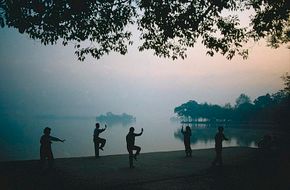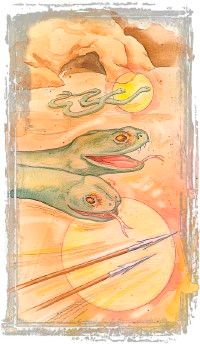One important component of the martial applications of tai chi are the eight techniques. These techniques are related to two Taoist theories that form the basis of martial tai chi.
In the first theory, Wu Chi gives birth to the yin and the yang and the interaction of these primal energies creates the eight forces of nature: heaven, earth, lake, mountain, wind, thunder, water, and fire.
There is a second theory, known as the Five Element Theory. This theory is also called the Five Phase Theory because the relationship between the elements is expressed as the movement or transformation demonstrated in the diagram of the cycles of destruction and creation.
When the symbols for the eight forces of nature are coupled with those of the five phases, thirteen configurations result. These formations are related to thirteen fundamental tai chi ideas. These include eight distinct martial techniques that are applied within five sets of movements.
The Eight Techniques and Their Trigrams
The original eight trigrams are used to form the hexagrams of the I Ching and correspond to the three levels of existence: The uppermost line represents heaven; the middle line, humanity; and the lowest line, earth. These trigrams are very ancient and even predate the creation of the I Ching.
The idea behind the trigrams is attributed to the mythical ruler Fu Hsi who lived more than 5,000 years ago during the early era when hunting and fishing were the primary occupations.
When the elements are organized into opposing pairs and associated with the points of the compass, the arrangement is known as the "Sequence of Earlier Heaven" or sometimes as "The Primal Arrangement." Heaven and earth are associated with south and north, mountain and lake with northwest and southeast, fire and water with the east and west, and, thunder and wind with the northeast and southwest.
From this basic structure, tai chi chuan uses the trigrams as a means of representing information. Eight fighting techniques, movements known as the "Eight Gates," are assigned to particular trigrams.
Like the elements themselves, the eight techniques are organized into complementary and opposing pairs of yang and yin grouped as follows; ward off and roll back, press and push, pull down and split, elbow stroke and shoulder stroke.
Since these movements are associated with an element, they are also associated with a direction and are arranged in pairs of complementary opposites around the Tai Chi symbol. The eight trigrams are divided into two halves, known as the four cardinal directions (S, N, E, W) and the four corners (SE, NE, SW, NW).
The south is the location of heaven. It is represented by three yang lines, indicating the greatest concentration of yang chi in the entire system. In terms of tai chi, this translates into the most powerful and aggressive force. When coupled with the creativity associated with heaven, it becomes the epitome of intelligently applied force. The tai chi movement associated with this hexagram is known as ward off.
The north is the direction of earth. This is the trigram of roll back, the complement to ward off. True to theory, rollback is denoted by three broken lines. Rather than seeking to confront, this move indicates a retreat. By yielding strategically, the target disappears and the efforts of the opponent are diffused harmlessly.
In ward off and roll back we again see the pattern of advance and yield, of the hard and the soft; two forces that are fully equal, each unmatchable in its own right.
Press, indicated by the trigram for water, is assigned to the west. It is signified by two broken lines with a solid line between. Its complement, push, symbolized by fire, is found in the east. This trigram is two solid lines separated by a broken line.
The four corners are represented in the northeast by thunder and its movement, split, and in the southwest by wind and its movement, pull. Mountain is located in the northwest. Its movement is the shoulder stroke. Lake, its complement, is in the southeast. Its move is an elbow stroke.
As you might imagine, applying the eight techniques is not a simple matter. First of all, each of the moves indicated by the eight trigrams must be learned. A push, for example, does not mean simply pushing someone away or down with brute force. The action refers to a detailed sequence of movements executed in a precise way. Further, each of the eight techniques can be found in several different places in the complete set of tai chi postures.
Continue reading to learn about the Five Phase Theory which is also part of the martial applications of tai chi.
To learn more about tai chi and Taoism, see:



